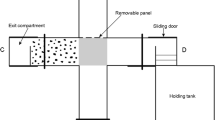Abstract
We explored tiger salamanders’ (Ambystoma tigrinum) learning to execute a response within a maze as proximal visual cue conditions varied. In Experiment 1, salamanders learned to turn consistently in a T-maze for reinforcement before the maze was rotated. All learned the initial task and executed the trained turn during test, suggesting that they learned to demonstrate the reinforced response during training and continued to perform it during test. In a second experiment utilizing a similar procedure, two visual cues were placed consistently at the maze junction. Salamanders were reinforced for turning towards one cue. Cue placement was reversed during test. All learned the initial task, but executed the trained turn rather than turning towards the visual cue during test, evidencing response learning. In Experiment 3, we investigated whether a compound visual cue could control salamanders’ behaviour when it was the only cue predictive of reinforcement in a cross-maze by varying start position and cue placement. All learned to turn in the direction indicated by the compound visual cue, indicating that visual cues can come to control their behaviour. Following training, testing revealed that salamanders attended to stimuli foreground over background features. Overall, these results suggest that salamanders learn to execute responses over learning to use visual cues but can use visual cues if required. Our success with this paradigm offers the potential in future studies to explore salamanders’ cognition further, as well as to shed light on how features of the tiger salamanders’ life history (e.g. hibernation and metamorphosis) impact cognition.



Similar content being viewed by others
References
Burghardt GM (2013) Environmental enrichment and cognitive complexity in reptiles and amphibians: concepts, review, and implications for captive populations. Appl Anim Beh Sci 147:286–298. doi:10.1016/j.applanim.2013.04.013
Chen Y, Znoiko S, DeGrip WJ, Crouch RK, Ma J (2008) Salamander blue-sensitive cones lost during metamorphosis[dagger]. Photochem Photobio 84:855–862
Cheng K, Spetch ML (1998) Mechanisms of landmark use in mammals and birds. In: Healy S (ed) Spatial representation in animals. Oxford University Press, New York, NY, pp 1–17
Daneri MF, Casanave EB, Muzio RN (2015) Use of local visual cues for spatial orientation in terrestrial toads (Rhinella arenarum): the role of distance to a goal. J Compar Psych 129:247–255. doi:10.1037/a0039461
David RS, Jaeger RG (1981) Prey location through chemical cues by a terrestrial salamander. Copeia 1981(2):435–440. doi:10.2307/1444234
Davis S, Singer J (1967) The acquisition and extinction of instrumentally conditioned approach behaviour in the tiger salamander. Psychon Sci 8:383–384
Dorries KM, White J, Kauer JS (1997) Rapid classical conditioning of odor response in a physiological model for olfactory research, the tiger salamander. Chem Sense 22:277–286
Gillette JR, Jaeger RG, Peterson MG (2000) Social monogamy in a territorial salamander. Anim Behav 59:1241–1250
Howard RD, Moorman RS, Whiteman HH (1997) Differential effects of mate competition and mate choice on eastern tiger salamanders. Anim Behav 53:1345–1356
Maier NF, Schneirla TC (1935) Principles of animal psychology. McGraw-Hill, NY, US
Mason JR, Stevens DA, Rabin MD (1980) Instrumentally conditioned avoidance by tiger salamanders (Ambystoma tigrinum) to reagent grade odorants. Chem Sense 5:99–105
Packard MG, McGaugh JL (1996) Inactivation of hippocampus or caudate nucleus with lidocaine differentially affects expression of place and response learning. Neurobiol Learn Mem 65:65–72
Przyrembel C, Keller B, Neumeyer C (1995) Trichromatic colour vision in the salamander (Salamandra salamandra). J Comp Physiol 176:575–586
Ray AJ (1970) Instrumental avoidance learning by the tiger salamander (Ambystoma tigrinum). Anim Behav 18:73–77
Reynolds GS (1961) Attention in the pigeon. J Exp Analy Behav 4:203–208
Schwartz JM, Cogan DC (1977) Position discrimination in the salamander, Ambystoma tigrinum. Dev Psych 10:355–358
Shettleworth SJ (2010) Cognition, evolution, and behavior, 2nd edn. Oxford University Press, New York, NY
Sincsch U (2006) Orientation and navigation in Amphibia. Marine Freshw Behav Physiol 39:65–71
Sotelo MI, Bingman VP, Muzio RN (2015) Goal orientation by geometric and feature cues: spatial learning in the terrestrial toad Rhinella arenarum. Anim Cognit 18:315–323. doi:10.1007/s10071-014-0802-8
Stancher G, Rugani R, Regolin L, Vallortigara G (2015) Numerical discrimination by frogs (Bombina orientalis). Anim Cognit 18:219–229. doi:10.1007/s10071-014-0791-7
Stebbins RC, Cohen NW (1995) A natural history of amphibians. Princeton University Press, New York
Tolman EC, Ritchie BF, Kalish D (1946) Studies in spatial learning. II: place learning versus response learning. J Exp Psychol 36:221–229
Uller C, Jaeger R, Guidry G, Martin C (2003) Salamanders (Plethodon cinereus) go for more: rudiments of number in an amphibian. Anim Cognit 6:105–112
Acknowledgments
The authors would like to thank Bethel Nicholas for her help in the first of these experiments. This work was supported by a Summer Research Institute grant from Hood College and the Faculty Development Fund at Hood College. These studies comply with the ethical standards of the USA for the use of animals as research subjects. We have no conflicts of interest to report.
Author information
Authors and Affiliations
Corresponding author
Ethics declarations
Conflict of interest
None.
Rights and permissions
About this article
Cite this article
Kundey, S.M.A., Millar, R., McPherson, J. et al. Tiger salamanders’ (Ambystoma tigrinum) response learning and usage of visual cues. Anim Cogn 19, 533–541 (2016). https://doi.org/10.1007/s10071-016-0954-9
Received:
Revised:
Accepted:
Published:
Issue Date:
DOI: https://doi.org/10.1007/s10071-016-0954-9




